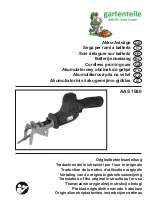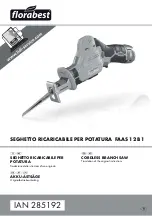
GB/IE/NI
6
5
Do not mix old and new batteries or batteries of dif-
ferent types or manufacturers! Replace an entire set of
batteries at the same time.
6
Immediately remove used batteries from the device and
dispose of them properly! Do not dispose batteries with
household waste. Defective or used batteries must be
recycled according to Directive 2006/66 / EC.
Give back batteries and / or the device has been of-
fered to the collective facilities. About disposal facilities
you can inform by your municipal or city government.
7
Do not allow batteries to heat up!
8
Do not weld or solder directly on batteries!
9
Do not dismantle batteries!
10
Do not allow batteries to deform!
11
Do not throw batteries into fire!
12
Keep batteries out of the reach of children.
13
Do not allow children to replace batteries without
supervision!
14
Do not keep batteries near fire, ovens or other sources
of heat. Do not use batteries in direct sunlight or store
them in vehicles in hot weather.
15
Keep unused batteries in the original packaging
and keep them away from metal objects. Do not mix
unpacked batteries or toss them together! This can
lead to a short-circuit of the battery and thus damage,
burns or even the risk of fire.
16
Remove batteries from the equipment when it will not
be used for an extended period of time, unless it is for
emergencies!
17
NEVER handle batteries that have leaked without
appropriate protection. If the leaked fluid comes into
contact with your skin, the skin in this area should be
rinsed off under running water immediately. Always
prevent the fluid from coming into contact with the
eyes and mouth. In the event of contact, please seek
immediate medical attention.
18
Clean the battery contacts and corresponding con-
tacts in the device prior to inserting the batteries.
Residual risks
The machine has been built according to the
state of the art and the recognised technical
safety requirements. However, individual
residual risks can arise during operation.
• Health hazard due to electrical power, with the use of
improper electrical connection cables.
• Furthermore, despite all precautions having been met,
some non-obvious residual risks may still remain.
• Residual risks can be minimised if the “Important informa-
tion”, „Additional safety instructions“ and the „Proper
use“ are observed along with the whole of the operating
instructions.
• Do not load the machine unnecessarily: excessive pres-
sure when sawing will quickly damage the saw blade,
which results in reduced output of the machine in the pro-
cessing and in cut precision.
• When cutting plastic material, please always use clamps:
the parts which should be cut must always be fixed be-
tween the clamps.
• Avoid accidental starting of the machine: the operating but-
ton may not be pressed when inserting the plug in an outlet.
• Use the tool that is recommended in this manual. In do-
ing so, your mitre saw provides optimal performance.
• Hands may never enter the processing zone when the
machine is in operation.
• Release the handle button and switch off the machine
prior to any operations.
Assembly
WARNING! For you own safety, only insert
the mains plug in an outlet when all as-
sembly steps have been completed and you
have read and understood the safety and
operating instructions.
Lift the saw out of the packaging and place it on your work
bench. (Positioning of the saw on the work bench - see the
next page under „POSITIONING / WORK STATION“)
Installation of the dust bag (fig. 2)
• Squeeze together the metal ring on the chip bag (12)
and attach it to the outlet opening in the motor area.
Assembling the work piece clamping de-
vice (fig. 1.1)
• Loosen the locking screw (17) and attach the work piece
clamping device (10) to the left or right of the fixed saw bench.
• Afterwards, retighten the locking screws (17).
Assembling the work piece supports (fig.
1.1 – 1.2)
• Loosen the cross-head screw (14) and guide the work
piece support through the specified hole on the side of
the fixed saw bench.
• Make sure that the work piece support (15) is also
guided through the two plates (19) on the underneath.
• Afterwards, retighten the cross-head screw (14).
• Repeat this process on the other side.
Assembling the support stand (fig. 1.1 – 1.2)
• Loosen the cross-head screws (18) on the underneath of
the saw and guide the support stand (16) through the
specified holes on the back of the saw.
• Afterwards, retighten the cross-head screws (18).
Commissioning
Prior to commissioning, observe the safety
instructions in the operating instructions.
REMOVAL FROM THE PACKAGING
Remove the machine from its package, which protects it during
transport, without damaging the package in order to be able to
use it later for transporting the mitre saw for long-term storage.
MOVING
Since the mitre saw is relatively small and light, its location
can be easily changed, even by a single person. After lock-
ing the locking knob (26 - Fig. 4) in the bottom position, lift
the mitre saw by the handle (34 - Fig. 4).
Summary of Contents for 290768
Page 5: ...Fig 5 28 29 6 2 3 27 26 1 34 Fig 4 Fig 5 Fig 7 32 31 Fig 7 Fig 6 30 33 Fig 6...
Page 17: ...GR CY 12 13 14 14 16 18 19 19 20 20 20 21 21 21 22 22 24 72...
Page 19: ...GR CY 14 S6 10 25 3 mm 10 mm LpA 99 6dB A K 3dB A LwA 112 6dB A K 3dB A 85 dB A Zmax 0 27 1 2...
Page 20: ...GR CY 15 3 4 18 16 5 N 6 7 8 9 10 11 12 13 14 15 16 17 18 19...
Page 21: ...GR CY 16 20 21 22 23 1 EN 847 1 HSS 2 3 45 90...
Page 22: ...GR CY 17 1 2 3 4 5 6 7 1 3 8 9 10 11 12 13 14 15 16 2...
Page 23: ...GR CY 18 1 2 3 4 5 6 2006 66 7 8 9 10 11 12 13 14 15 16 17 18...
Page 24: ...GR CY 19 26 4 34 4 34 4 90 95 cm 80 cm 2 12 1 1 17 10 17 1 1 1 2 14 15 19 14 1 1 1 2 18 16 18...
Page 27: ...GR CY 22 30 V VDE DIN VDE DIN H 07 RN 230 V 25 m 1 5...
Page 28: ...GR CY 23...
Page 29: ...GR CY 24 3...
Page 78: ...147 148...












































